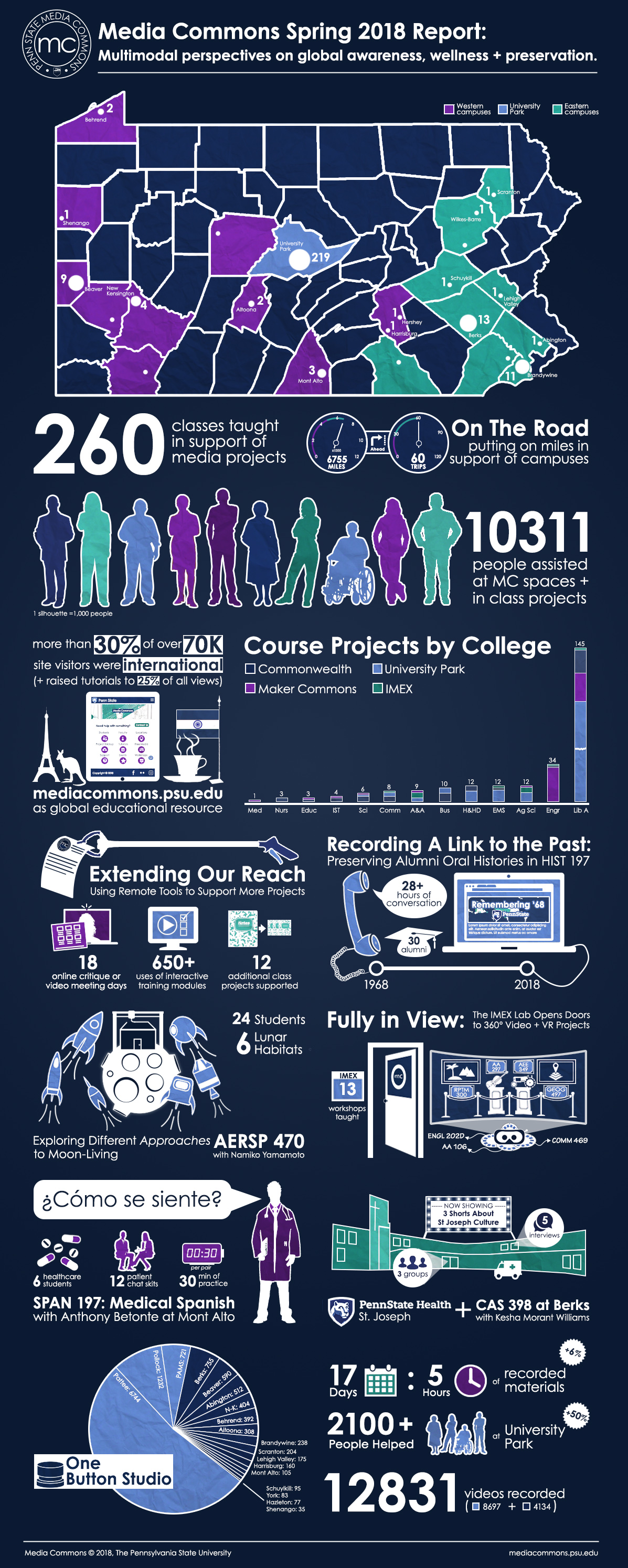
Spring 2018 Report
Spring 2018 saw 10,311 students and faculty use the Media Commons, Maker Commons, and Immersive Experiences Lab initiatives across the Commonwealth. Much of this use was focused in 260 classes in nearly every discipline offered at Penn State. To facilitate these interactions outside of University Park, traveling consultants visited campuses 60 time (logging over 6,700 miles) to offer instruction and consultations.
Projects continue to flow largely from the College of Liberal Arts (145) but great strides were make with Engineering (34), thanks largely to the Maker Commons and its 3D printing services. The colleges of Agricultural Sciences, Earth & Mineral Sciences and Health & Human Development each tied for (12) projects and the School of Medicine joined the list for the first time in Spring 2018 with a making project.
Rounding out its first full year in operation after a Spring 2017 semester redesign and relaunch, the Media Commons website performed exceptionally well. The number of unique visitors reached 70,267, an increase of 32% from the Fall 2017 semester. Continuing a trend from Fall, many of the specific sub-topic tutorials are now ranking as top 10 content: Taken together, these tutorials alone saw a 51% increase in traffic while just three tutorials now represent 25% of all pageviews.
Remote tools have allowed the Media Commons staff (which has not grown) to continue adding on meaningful projects with faculty across the Commonwealth. The use of videoconferencing tools like Zoom and our growing library of Interactive Training Modules enabled the team to on-board the equivalent of 12 additional class projects that would have otherwise gone unsupported in the Spring.
HIST 197 at University Park focused their semester on the year 1968. The students were tasked with scheduling and recording an oral history using the Media Commons podcasting resources. Students recorded an interview they conducted with a Penn State alumni that attended school in 1968 and then added their interview to an online collection of 1968 stories at 1968.psu.edu.
AERSP 470 at University Park, an Advanced AeroSpace Structures class, was given the task of designing and building a robust moon habitat on a vacant 10m x 10m lot using additive manufacturing. To simulate this the students 3D printed a prototype habitat on a 1:100 scale and conducted a structural analysis on the printed object.
The structure needed to withstand certain loads and pressures while maximizing the living area and also minimizing the habitat weight/volume to save the precious resources.
This was the first semester that the Immersive Experiences Lab was fully operational and overall we had a very successful launch of the service. We worked with 7 different classes across 6 different disciplines, teaching a total of 13 workshops and helping 330 people with different aspects of either creating or viewing immersive experiences. The types of projects ranged from simply assigning a viewing experience, as RPTM 300 at University Park did in order to assess how the technology might be used in the tourism industry, to producing a full 360° video experience. This semester, we had 4 classes produce video content. AA 297 (UP) explored how 360 technology might be used in music education, while AA 106 (UP) used 360° footage to experiment with different ways to lay graphics on top of the videos using Adobe After Effects. AEE 349 (UP) created agriculture training videos while GEOG 497 (UP) worked with footage to incorporate it into VR settings.
At Mont Alto, Anthony Betonte’s new SPAN 197 course offers students a chance to practice their medical terminology in realistic skits of their own creation. The One Button Studio allows easy recordings so that they can focus on honing their Spanish language skills.
In CAS 398 at Berks, professor Kesha Morant-Williams challenged her students to make public service announcements/commercials for Penn State St. Joseph Medical Center. The students were required to create videos using iMovie and to coordinate with different members of the hospital administration. At the end of the semester the students presented their final products to the hospital administration in hopes that the videos would be used by them in the future. This assignment gave the students a real life client to work with and the opportunity to create marketing materials for that client.
One Button Studios at 17 campuses helped students and faculty create 12,831 academic videos, comprising over 17 straight days of video. Students across the Commonwealth also created 3,971 3D prints in pursuit of their own curiosity and course work.
